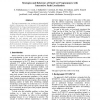Free Online Productivity Tools
i2Speak
i2Symbol
i2OCR
iTex2Img
iWeb2Print
iWeb2Shot
i2Type
iPdf2Split
iPdf2Merge
i2Bopomofo
i2Arabic
i2Style
i2Image
i2PDF
iLatex2Rtf
Sci2ools
VL
2003
IEEE
2003
IEEE
Strategies and behaviors of end-user programmers with interactive fault localization
End-user programmers are writing an unprecedented number of programs, due in large part to the significant effort put forth to bring programming power to end users. Unfortunately, this effort has not been supplemented by a comparable effort to increase the correctness of these often faulty programs. To address this need, we have been working towards bringing fault localization techniques to end users. In order to understand how end users are affected by and interact with such techniques, we conducted a think-aloud study, examining the interactive, human-centric ties between end-user debugging and a fault localization technique. Our results provide insights into the contributions such techniques can make to an interactive end-user debugging process.
| Added | 05 Jul 2010 |
| Updated | 05 Jul 2010 |
| Type | Conference |
| Year | 2003 |
| Where | VL |
| Authors | Shrinu Prabhakararao, Curtis R. Cook, Joseph R. Ruthruff, Eugene Creswick, M. Main, Mike Durham |
Comments (0)

